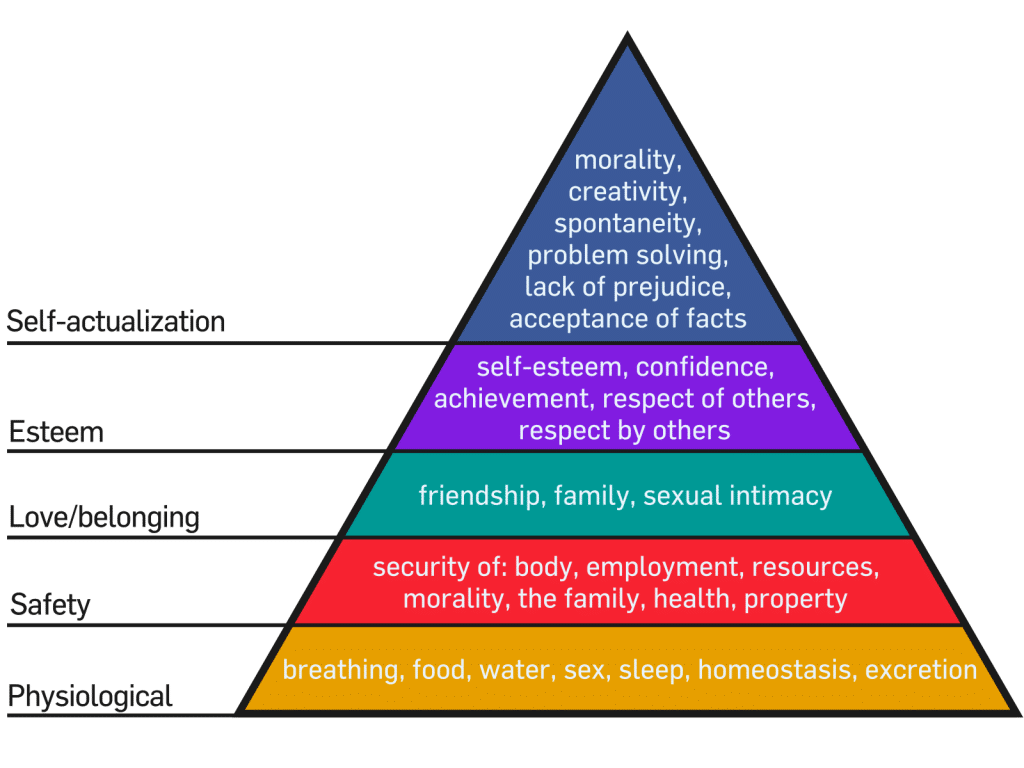 If you’re interested in psychology, then you’ll appreciate learning about Maslow’s Hierarchy of Needs in education. Read on…
If you’re interested in psychology, then you’ll appreciate learning about Maslow’s Hierarchy of Needs in education. Read on…
Psychologists say that all human beings are motivated by goal accomplishment. It allows us to meet our individual wants and needs that are mentally prioritized in order of importance.
Maslow stated that we move from satisfying the lower-priority needs to those of higher-priority.
In other words, less immediate needs must be completely met before more important ones can be satisfied.
That principle underlies Maslow’s concept called…
Maslow’s Hierarchy of Needs
Below, we are considering how it can be applied in education. But first let’s discuss some general information.
Learn more about Maslow’s Pyramid
 At the bottom of Maslow’s pyramid, you can see physiological needs, such as nourishment, sleep, clothing, and shelter. They are the first priority, which means that they must be satisfied first in order to focus on anything else.
At the bottom of Maslow’s pyramid, you can see physiological needs, such as nourishment, sleep, clothing, and shelter. They are the first priority, which means that they must be satisfied first in order to focus on anything else.
For example, if a person is hungry, they ignore any other desires. As a student, you can notice that if you haven’t had food for a long time, it’s impossible to focus on your studies.
But once your physiological needs are satisfied, another priority arises: Safety.
If one doesn’t feel safe in their environment, they struggle to complete any kind of work.
People thrive only in a predictable and well-structured environment with no disruptions in their routines. You can read more about it in essays about Maslow’s hierarchy of needs published on trusted online resources.
They say that love and a sense of belonging come after physiological and safety requirements.
Those 2 needs can be developed through…
Believe it or not, the need for “love” and “belonging” is as critical as “physiological needs.”
Just after that, the need for “self-esteem” come.
This need involves:
Only if those needs are met, one can feel strong, capable, adequate and worthy. Otherwise, one feels unimportant, incompetent and unprotected.
One more need following those mentioned above is self-actualization.
Maslow defines it as an aspiration to fulfill one’s own potential that is driven by a craving for self-improvement. He suggests that far not all people are able to attain this level. But those who can reach it are independent, realistic and analytical.
Maslow’s theory in education
 To achieve great learning outcomes, student needs must be met in a school environment.
To achieve great learning outcomes, student needs must be met in a school environment.
Let’s consider how to do it on each level.
1. Physiological needs
The first and most obvious thing students must have at school are…
It would be great if they had a mixed snack bar too.
If schools offered daily snack breaks, students could grab some energy bites from time to time and continue learning without feeling hungry.
Students also need nice physical surroundings that include:
- proper room arrangements
- plants
- the right temperature
Some focused attention practices could be helpful as well.
For example…
Schools could teach and recommend breathing and mindfulness/visualization techniques – to help student to quiet their minds and stop free-flowing chaotic thoughts.
All of the above helps to create an inviting, warm and friendly physical environment.
2. Stability, safety and security
If schools want to promote safety, teachers can invite a variety of speakers.
For example…
- Police officers, counselors and even former students who have overcome difficult situations successfully.
Students can also use so-called worry drop boxes.
As they enter a classroom, they can drop a piece of paper with a written concern in a box situated by the door.
Psychologists say that this technique relieves anxiety and frees up the working memory.
Another idea to create a safe atmosphere:
Teachers can assign students to make pin-ups with a compliment or affirmation each day. This helps everyone focus on positive experiences instead of faults and mistakes.
3. Belonging and love
The needs of “Belonging” and “Love” can be met through classroom service projects and partnered work.
Teachers can also organize a so-called community circle.
How to do it?
At the beginning and ending of each class, students can discuss and bring empathy to life. Instructors can even assign some roles within the class, including a listener, recorder of feelings and a person who cares for others.
Another idea:
Students might share personal narratives, stories and movie clips.
Plus yet another great idea:
Schools and students can plan special celebratory days, such as progress days, birthdays and strength days.
4. Achievement, recognition and respect
In order to help students feel successful, schools can organize so-called expert days.
How do you organize expert days?
- On those days everyone is supposed to show their personal expertise.
- Students can also display their skills by creating quizzes and assignments for other classes.
- Additionally, it would be helpful to bring in some community members or graduates who can share the possibilities of academic success after high school.
5. Self-actualization and self-fulfillment
If schools want to help to meet these needs, they must help students to understand what their purpose in life is – and how they can serve the world.
Schools should prioritize students becoming self-assessors and self-reflectors.
Once students begin to realize how their thoughts, feelings and actions affect all lives, they will be able to find a way for self-actualization.
Author’s BIO : Jeremy Raynolds is a psychologist working with college students. He helps them improve their cognitive skills and solve mental health issues. Jeremy believes that psychological care must be the highest priority for learners because they experience too much stress while studying.
Stay Calm During Stressful Times
Join my groundbreaking video course: The Anxiety Cure.
P.S. Before you zip off to your next Internet pit stop, check out these 2 game changers below - that could dramatically upscale your life.
1. Check Out My Book On Enjoying A Well-Lived Life: It’s called "Your To Die For Life: How to Maximize Joy and Minimize Regret Before Your Time Runs Out." Think of it as your life’s manual to cranking up the volume on joy, meaning, and connection. Learn more here.
2. Life Review Therapy - What if you could get a clear picture of where you are versus where you want to be, and find out exactly why you’re not there yet? That’s what Life Review Therapy is all about.. If you’re serious about transforming your life, let’s talk. Learn more HERE.
Think happier. Think calmer.
Think about subscribing for free weekly tools here.
No SPAM, ever! Read the Privacy Policy for more information.
One last step!
Please go to your inbox and click the confirmation link we just emailed you so you can start to get your free weekly NotSalmon Happiness Tools! Plus, you’ll immediately receive a chunklette of Karen’s bestselling Bounce Back Book!


 If you’re interested in psychology, then you’ll appreciate learning about Maslow’s Hierarchy of Needs in education. Read on…
If you’re interested in psychology, then you’ll appreciate learning about Maslow’s Hierarchy of Needs in education. Read on… At the bottom of Maslow’s pyramid, you can see physiological needs, such as nourishment,
At the bottom of Maslow’s pyramid, you can see physiological needs, such as nourishment,  To achieve great learning outcomes, student needs must be met in a school environment.
To achieve great learning outcomes, student needs must be met in a school environment. 